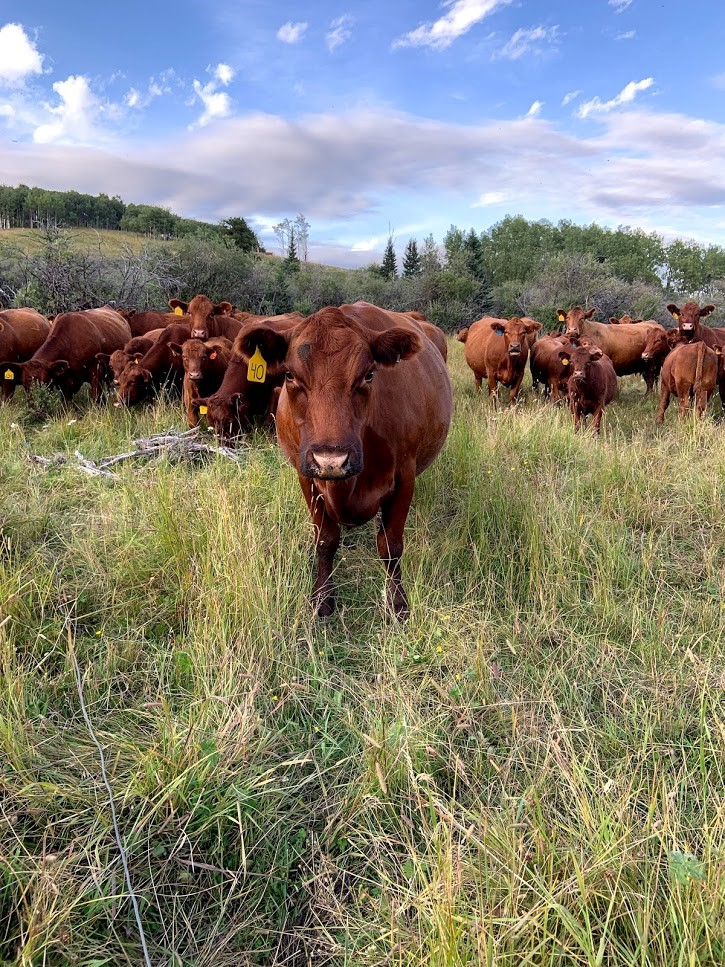Study to apply rigorous scientific method to range riding technique as method of predator management on cattle ranches.
January 26, 2020

To protect livestock from predators in western Canada, University of Wisconsin-Madison researchers are testing whether cattle that are urged to live as a herd will protect themselves from wolves and bears.
Under examination is the principle that cattle will find safety by returning to their roots as herd animals, according to University of Wisconsin-Madison graduate student Naomi Louchouarn, who began the experiment last spring.
“If you see a herd of wild ungulates, say wildebeest or caribou, facing a threat, they always have the larger adults on the outside, facing out. That puts more eyes out to spot problems, and it also makes a lot more bodies for a predator to deal with,” Louchouarn said. "That’s why predators — lions, wolves, whatever — try to separate one animal from the herd.”
The experiment will test procedures developed by stockman Joe Englehart in the foothills of Alberta’s Rocky Mountains, just north of the U.S. border. Each summer, Englehart is the superintendent of about 6,500 head of cattle owned by 38 farms in the Spruce Ranching Co-op located about 30 miles southwest of Calgary, Alb.
Englehart gently encourages herds to gather in the afternoon — since most predators attack at night. He also tries to reduce stress by, for example, excluding herding dogs if they “spook” a particular herd. He thinks reducing stress can reduce diseases such as pneumonia that can make animals more vulnerable to carnivores, the announcement said.
“When Joe’s moving a herd, he’ll move it slowly, in a way that feels more natural,” Louchouarn said. “If he needs to pass through multiple fields, he may take them to an intermediate field and let them stay a day or two until they seem calm, before moving to the next. He won’t rush the process.”
The effects of Engelhart’s herding practices were obvious to Louchouarn, who spent last summer on the range. “If you walk toward them, you will hear mothers yelling for their calves, and they will turn into a herd that you can’t go near,” she said.
Domesticated ungulates — cattle — are bred for submissiveness rather than vigilance, and the benefits of Engelhart’s herding techniques are unproven. Thus, the experiment in Alberta, which is supported by the nonprofit Animal Welfare Institute, is taking a closer look.
The four-month experiment splits the herd in half. In one half, during a two-month control period, Engelhart tends a group of cows alone. For the next two months, his management is augmented by a second range rider using similar techniques.
The other half of the animals get the same experience, but in the opposite order.
The study is housed at the Carnivore Coexistence Lab at the University of Wisconsin-Madison. Louchouarn’s adviser is Adrian Treves, a professor at the Nelson Institute for Environmental Studies at the university, directs the lab.
Using stockmen — range riders — to deter predation is an old idea, Louchouarn said, adding, “Cowboys have been doing it for a long time, but usually, they focus on predators, [and] less on livestock. If they see a wolf or a bear, they try to chase it off or follow it or often try to kill it, but Joe says that does not work, because you end up leaving the livestock behind, and they get stressed, and the wolf and grizzly bear are much sneakier than we are.”
The effects of predator control are seldom tested, Treves said, but when they are, non-lethal controls are often superior to lethal controls, such as shooting or poisoning. In a 2016 study, Treves and colleagues reviewed published studies that he said “met the accepted standard of scientific inference.” Five studies used non-lethal methods, and seven used lethal methods. Four non-lethal and two lethal methods did reduce livestock predation, he said, but two methods — both lethal — were linked to increased predation, possibly because the removal of top predators allowed smaller predators to flourish.
The current study is the first to apply rigorous scientific method to range riding, Treves said.
“We need randomized, controlled trials before farmers and the public get advice on methods for predator control, and definitely before governments invest resources in them,” he said.
Curiously, in the Alberta study area, losses to carnivores seem considerably lower than losses due to poison, weather and disease, Louchouarn said. The Alberta government compensated ranchers about $59,000 (U.S.) for carnivore losses in the region between 2015 and 2018. “Nonetheless, the majority of ranchers living here will experience losses to carnivores at some point, so the perception of losses is still high,” she said.
This study was funded, in part, by grants from the Animal Welfare Institute, the Yellowstone to Yukon Conservation Initiative and Wolf Awareness Inc.
You May Also Like


.png?width=300&auto=webp&quality=80&disable=upscale)
